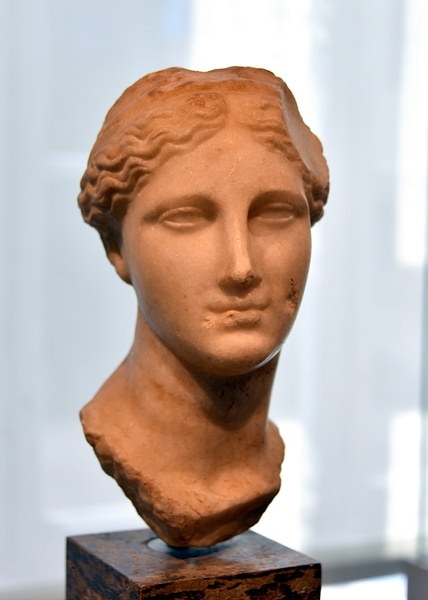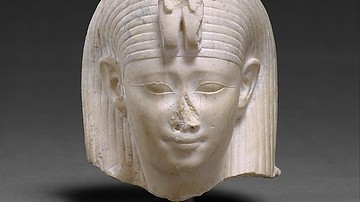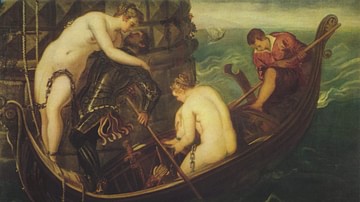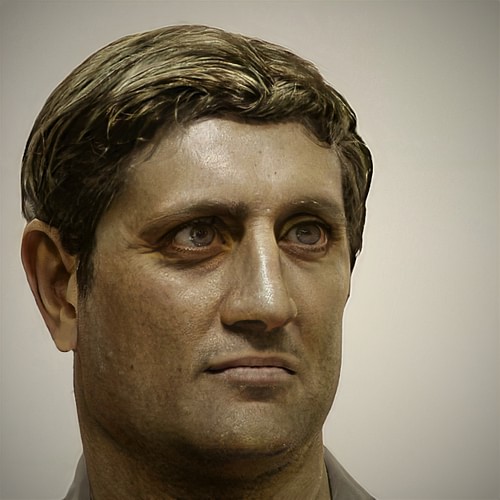
Ptolemy II Philadelphus ("The Sibling Loving", r. 282-246 BCE) was the second ruler of the Ptolemaic Dynasty. He consolidated the kingdom conquered by his father Ptolemy I and presided over its golden age. Ptolemy II invested heavily in Alexandria, overseeing the completion of the Library of Alexandria and the Lighthouse of Alexandria, one of the Seven Wonders of the Ancient World.
Ptolemy II ruled through a combination of hard and soft power, influencing some states through diplomacy while funneling resources toward wars against his rivals in Africa, Asia, and Greece. The Ptolemaic kingdom reached its furthest extent during his reign. These efforts were funded by economic policies that increased Egypt's agricultural and financial output. With his sister-wife Arsinoe II Philadelphus, he instituted a cultural and religious program that solidified the Ptolemaic Dynasty as Egypt's divine rulers.
Youth & Succession
Ptolemy II was born in Kos in 308 or 309 BCE to Ptolemy I and Berenice I of Egypt, his third wife. Ptolemy II had a full-blooded sister, Arsinoe II (l. c. 318/311 to c. 270/268 BCE), and several half-siblings, many of whom were destined to rule themselves. On his father's side, his half-brothers Ptolemy Keraunos (also spelled Ceraunus, r. 281-279 BCE) and Meleager (r. 279 BCE) were each briefly king of Macedon, and his half-sister Lysandra was queen consort to Alexander V of Macedon (r. 297-294 BCE). On his mother's side, his half-brother Magas (r. 276-250 BCE) was king of Cyrene, and his half-sister Antigone was queen consort to Pyrrhus (c. 319-272 BCE).
Shortly after his birth, Ptolemy II and the rest of his family relocated to Alexandria, Egypt's capital. As a youth, Ptolemy II was tutored by some of the brightest minds of Greek literature and Greek philosophy, including Philetas of Cos (c. 340 to c. 385 BCE), Zenodotus of Ephesus (c. 325-260 BCE) the first head of the Library of Alexandria, and Strato of Lampascus (c. 340/330-269 BCE), director of the Lyceum. This educational background contributed to his patronage of the Library of Alexandria later in life.
Ptolemy I decided to pass over Ptolemy Keraunos, his firstborn son by his previous wife Eurydike, so that Ptolemy II could become regent. This decision may have been motivated by Berenice, who naturally wanted her own son to rule. Ptolemy II became co-ruler with his father around 284 BCE. This decision was contested by prominent figures in the Alexandrian court like Demetrius of Phalerum (c. 350-280 BCE), who supported the claims of Ptolemy I's older sons by Eurydike.

Upon Ptolemy I's death in 282 BCE, Ptolemy II became ruler of Egypt, Cyrene, Coele-Syria, Phoenicia, and Cyprus. Ptolemy II immediately set about strengthening his claim by removing all those who refused to acknowledge his rule. He executed two of his half-brothers who attempted to usurp him or stir up rebellion. Demetrius of Phalerum was exiled to Upper Egypt, where he died. Over the course of his reign, Ptolemy II would face challenges from his other brothers. However, Ptolemy Keraunos ended up relinquishing his claim to the Egyptian throne after attaining the Kingdom of Macedon in 281 BCE.
Marriages
Ptolemy II married Arsinoe I, the daughter of Lysimachus of Thrace shortly after the death of his father. Their marriage produced several children, including King Ptolemy III (r. 246-222 BCE) and the Seleucid queen Berenice Syra (r. 252-246 BCE). Meanwhile, Ptolemy II's full-blooded sister Arsinoe II married Lysimachus c. 300 BCE and had two sons by him. After the death of Lysimachus and her remarriage to Ptolemy Keraunus (who murdered two of her sons after the wedding), Arsinoe II fled to Egypt in the hopes that Ptolemy II would protect her.
Soon after Arsinoe II's arrival, Ptolemy II's first wife Arsinoe I was implicated in a conspiracy against him. Arsinoe I was exiled to Coptos in Upper Egypt, and Ptolemy II promptly married Arsinoe II. The marriage of full siblings was highly scandalous among the Greeks but was not uncommon in Egypt. Ptolemy II and Arsinoe provided religious validation for the union by referencing the precedent set by the Greek gods Zeus and Hera, and the Egyptian gods Osiris and Isis. Ptolemy II had the poet Sotades imprisoned and, according to one account, thrown into the sea in a lead box after he wrote an epigram mocking this incestuous marriage.
Ptolemy II was heavily influenced by Arsinoe II, who helped to shape his religious and imperial policy. They established the cult of the Theoi Adelphoi ("the Sibling Gods") and took the epithets Philadelphus. In later generations, sibling marriage became a defining feature of the Ptolemaic Dynasty. His marriage to Arsinoe II bore no children, so she adopted his children by Arsinoe I. Ptolemy II also had relationships with multiple official mistresses and concubines. Eleven courtesans are connected to Ptolemy II by ancient sources, including Stratonice and the Egyptian Didyme. The most prominent of these mistresses was Bilistiche, a Macedonian who won several Olympic chariot-racing events.
Reign
Some of the greatest achievements of Ptolemy II's reign were the establishment of institutions to manage the Ptolemaic empire and keep the peoples under its rule relatively united. Ptolemy II presented different faces to his subjects, to fit their cultural expectations of rulers. In propaganda directed at his Egyptian subjects, he presented the image of a pharaoh, while modeling himself after Alexander the Great in propaganda directed at his Greek subjects.
One of Ptolemy II's first acts was to deify his deceased parents, creating the Ptolemaic dynastic cult, which venerated them as savior gods. He later increased the importance of the cult by founding the Ptolemaieia, a four-yearly festival in Alexandria. The festival included games and competitions that drew athletes from around the Mediterranean and a grand procession through Alexandria.
The procession included servants bearing treasures and war trophies, foreign delegates, famous artisans, athletes, and Bacchanal devotees dressed as maenads. Exotic animals like elephants, antelopes, zebras, and lions were brought from every corner of the Ptolemaic empire. Images of Ptolemy, Alexander, and the Greek gods wheeled through the streets on ornate floats, highlighting the divine power of the dynasty. A parade of cavalry and foot soldiers brought up the rear of the procession. This event imitated the procession made by Dionysius, the Ptolemies' patron god, after he conquered Asia. It was also an occasion to showcase the wealth and might of Egypt.
And after them came twenty-four chariots drawn by four elephants each, and sixty chariots each drawn by a pair of goats, and twelve chariots by antelopes, and seven by oryxes, and fifteen by buffaloes, eight by pairs of ostriches, and seven by gnus, and four by pairs of zebras, and four chariots also drawn each by four zebras.
(Athenaus, Book 5, chapter 25)
Like his predecessors, Ptolemy II pushed an agenda of Hellenization and encouraged the use of Greek as an official language. He also instituted policies to encourage immigration from Greece and the former Achaemenid Empire. In particular, mercenaries and veterans of Alexander the Great's campaigns were enticed to come to Egypt, where they formed a population base from which Ptolemy II could recruit soldiers. Egyptian troops also played a role in the Ptolemaic military at this time, but not as much as in later eras.
Ptolemy II also made overtures toward his Jewish subjects, who played a notable role in the military and intellectual culture of Ptolemaic Egypt. He freed Jewish slaves who had been taken captive during his father's reign, some of whom joined the growing Jewish community in Alexandria. Other Jews were given their own units in the Ptolemaic army, alongside other ethnic units such as Thracians and Persians.
Patronage of the Arts & Sciences
Ptolemy II had a personal love of knowledge and oversaw the construction of the Library of Alexandria. In addition to being a repository of literature, the library also acted as a learning institution, similar to a modern university. Because of this, it drew many of the brightest minds in Greece to Alexandria, where they served the Ptolemaic court. One of the most significant scholarly achievements attributed to his reign is the composition of the Septuagint, a Greek translation of the Torah.
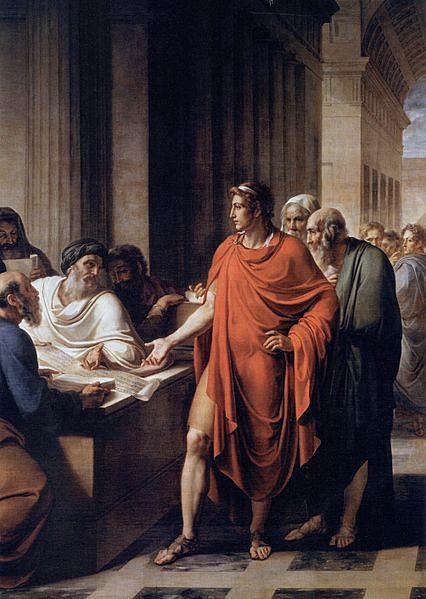
He sponsored court poets like Callimachus (c. 310-240 BCE), Theocritus (c. 300-260 BCE), and Apollonius of Rhodes (c. 3rd century BCE), who created literary works that glorified the Ptolemaic Dynasty. By presenting Ptolemy II's reign as a golden age, they helped to legitimize the Ptolemaic empire. Poetry produced by writers connected to the Alexandrian court exalted Ptolemy II's role as a divine savior, defending his subjects from barbarians and warfare by force.
The poetry sponsored by the Ptolemaic court also helped to shape a national identity for the Greeks living in Egypt, building historical and mythological connections between Greece and Egypt. Although the Library of Alexandria was most renowned for its literary output, it also hosted numerous mathematical and scientific advancements during the reign of Ptolemy II.
Economic Policy
Ptolemy II initiated numerous architectural and cultural projects throughout Egypt. One of the largest of these undertakings was the draining of marshes in the Faiyum and Oxyrhynchus, to create farmland for retired soldiers to settle on. The agricultural productivity of these regions further enriched the royal treasury. He also built various public works, including temples and monuments in the cities and countryside. Construction on the Lighthouse of Alexandria had already been begun by Ptolemy I but was likely completed by Ptolemy II.
These achievements were funded by the introduction of new taxes on business and agriculture by Ptolemy II and his chief finance minister Apollonius. Although Egypt had functioned without a formal currency for millennia, the Ptolemaic Dynasty quickly introduced a Greek system of coinage. One of the most important taxes created in his reign was the "salt tax", levied against every man, woman, and child in Egypt. To effectively schedule and collect these taxes, Ptolemy II reformed the fiscal calendar and implemented various censuses.

The economy of Ptolemaic Egypt and its access to key trade routes generated immense wealth for its rulers. The 5th-century CE author Jerome claims that Ptolemy II had annual revenue of 14,800 talents of silver and 1.5 million artabas of wheat. In historian J. G. Manning's estimation, Ptolemy II was the wealthiest man in the 3rd century BCE. Based on the average wage of a laborer at the time, it would take a person as much as 750,000 years to accumulate that much silver. However, many modern historians believe that the crown's wheat revenue was several times the amount reported by Jerome. This immense wealth enabled Ptolemy II to finance his exorbitant military expenditures.
Nubia & the Red Sea
Throughout the 270s BCE, Ptolemy II waged a series of military campaigns in the neighboring kingdom of Nubia. This was the only military campaign that Ptolemy II personally led. Out of these campaigns came the conquest of the Dodekaschoinos in lower Nubia, extending the Ptolemaic kingdom's border to its southernmost point. The Dodekaschoinos provided a corridor for the importation of gold and exotic game animals, most importantly war elephants. Trading hubs like Ptolemais Therou (literally "Ptolemais of the Hunt") were established along key roads to facilitate the elephant and ivory trade.
Ptolemy II also founded several settlements on the Red Sea. These settlements became points of entry for trade from East Africa, Arabia, and South Asia. This trade brought numerous commodities into Egypt, including frankincense, myrrh, black pepper, and Chinese silk. One of the most important of these ports was Berenice Troglodytica, which he named after his mother. In the Roman period, these ports were still the primary point of contact between India and the Mediterranean.

Military Expenditures
Ptolemy II waged various campaigns throughout his reign, often taking advantage of instability in neighboring kingdoms to expand the borders of the Ptolemaic empire. Historian Christelle Fischer-Bovet estimated that roughly 80% of the kingdom's revenue was spent on its military and navy during the reign of Ptolemy II. In addition to paying and arming soldiers from within his territories, he also fielded large numbers of mercenaries at great cost.
A significant portion of this military budget was also spent on the navy, which patrolled the Nile and protected Ptolemaic interests in the Mediterranean, Red Sea, and Indian Ocean. This fleet was larger than that of any other Mediterranean power at the time. At the beginning of his reign, Egypt had naval supremacy in the Mediterranean, and Ptolemy II led the League of the Islanders in the Cyclades.
[Ptolemy] takes slices of Phoenicia and Arabia and Syria and Libya and the dark-skinned Ethiopians; all the Pamphylians and the warriors of Cilicia he commands, and the Lycians and the Carians, who delight in war, and the islands of the Cyclades, for his are the finest ships sailing the ocean.
(Theocritus, lines 90-91)
Despite initiating several wars, modern historians consider Ptolemy II's foreign policy to be relatively timid in comparison to that of his contemporaries. He had minimal military experience at the time of his coronation, unlike many of his contemporaries. Unlike his warlike father, Ptolemy II took a hands-off approach to most wars, preferring to place most campaigns in the hands of his generals and admirals.
Wars with Macedon & the Seleucids
During the Syrian War of Succession (280-279 BCE), also known as the Carian War, Ptolemy II took advantage of the fact that the Seleucid king Antiochus I Soter was distracted by civil unrest. He annexed territories in Asia Minor, as far as Caria and Samos, which became an important naval base for the Ptolemaic Kingdom. In the First Syrian War (274-272/1 BCE), Ptolemy II was betrayed by his half-brother Magas, who was the Ptolemaic viceroy of Cyrene. Magas revolted against him and declared independence.

Supported by the Seleucids, Magas attempted to invade Egypt, but uprisings in Cyrene prevented this, and he was forced to make a peace accord with Ptolemy II. With Magas at bay, Ptolemy II was free to launch invasions of Seleucid-controlled Syria and Phoenicia, which proved largely unsuccessful. He had more success in the Aegean theatre, where he subjugated coastal cities in Miletos, Cilicia, Caria, and Lycia, establishing dominance in the region.
For being masters of Coele-Syria and Cyprus, [the Ptolemies] maintained a threatening attitude towards the kings of Syria, both by land and sea; and were also in a commanding position in regard to the princes of Asia, as well as the islands, through their possession of the most splendid cities, strongholds, and harbours all along the seacoast from Pamphylia to the Hellespont and the district round Lysimachia. Moreover they were favourably placed for an attack upon Thrace and Macedonia from their possession of Aenus, Maroneia, and more distant cities still.
(Polybius, 34.4-9)
Following these conflicts, Ptolemy II vied against Macedon for control of the Aegean. Ptolemy II allied with a coalition of Greek states led by Sparta and Athens who were rising up against Antigonid Macedon during the Chremonidean War (267-261). However, Egypt was almost completely ineffective at supporting its allies who were besieged and defeated by Antigonus II Gonatas (r. 277-239 BCE). Macedon crushed the Ptolemaic fleet at the Battle of Kos in 261 BCE.
Macedon and the Seleucid Empire allied against Egypt to establish dominance over the Aegean and Asia Minor during the Second Syrian War (260-253). This war resulted in the loss of most Ptolemaic territories in Greece and Asia Minor. Ptolemy II brought an end to the war by arranging a marriage between his daughter Berenice Syra and Antiochus II. The last few decades of Ptolemy II's reign were peaceful. In later generations, the Seleucid Empire and Macedon would continue to wage wars against the Ptolemaic kingdom, usually resulting in further losses of Ptolemaic territory.
Later Life & Death
By 268 BCE, Arsinoe II had died, and Ptolemy II appointed "Ptolemy the Son" as his heir. The identity of Ptolemy the Son is unclear, and modern scholars disagree over possible candidates. The most likely is Ptolemy of Telmessus, Arsinoe II's son by Lysimachus. Ptolemy II later had a falling out with his first heir and changed his heir to Ptolemy III.
Toward the end of his life, Ptolemy II reconciled with his half-brother Magas. Ptolemy II arranged a marriage between Ptolemy III and Magas' daughter Berenice II, which meant that Cyrene was restored to the Ptolemaic Kingdom after Magas' death. Ptolemy II died in 246 BCE, at the age of 62. He ruled actively for over 40 years, despite living with health issues including gout in his later years.
He was buried in the Sema, a royal mausoleum built to house the remains of Alexander the Great and the Ptolemaic dynasts. He is credited with setting the standard for all of the Ptolemaic monarchs who followed him. Egypt was more stable and long-lasting than any other successor state, which is partly attributable to him. The Ptolemaic kingdom was at its greatest extent during his reign, stretching from Greece to Nubia.

